How to Set Up WooCommerce Shipping for your Stores
Customers’ perceptions of your brand are heavily influenced by shipping. Customers obtain a high-quality shipping experience when everything comes together, from the quickness with which they receive a product to the cost of shipping.
Fortunately, WooCommerce includes various built-in shipping methods as well as expandable features that allow you to deliver more accurate shipping rates and provide your consumers a variety of options. You can also use shipping as a discounting method, such as providing free delivery on orders of a particular value.
Keep reading this topic about How to Set Up Your WooCommerce Shipping to have a better entire shipment operation.
How to set up Shipping Zones and Methods in WooCommerce
Step 1: Identify
Identifying your Shipping Zones is the first step in setting up WooCommerce shipping. This is the first step in establishing your order fulfillment procedure. WooCommerce shipping zones have two functions: they define the places (zones) to which you ship and they allow you to designate multiple Shipping Methods and/or Shipping Rates to certain zones.
You can, for example, use WooCommerce shipping zones to:
- We ship to every state in the United States, although orders to Hawaii and Alaska are more expensive.
- Ship to some overseas destinations, but not all.
- Limit liquor sales to places where you have a license, for example, by shipping to certain states.
- Create zones based on zip codes to enable local pickup.
- All of these shipping regulations are achievable thanks to WooCommerce shipping zones. To create zones, go to WooCommerce > Settings in your WordPress dashboard. A drop-down menu for Shipping Locations may be found about halfway down the settings page:

You can choose to ship to all of the nations to which you sell, as well as specific areas inside those nations. We chose that option because most sellers ship to all countries where they sell.
Step 2: Establish a Shipping zone
Then, in your WooCommerce settings, go to the Shipping tab and establish a Shipping Zone; this is the screen you’ll see:
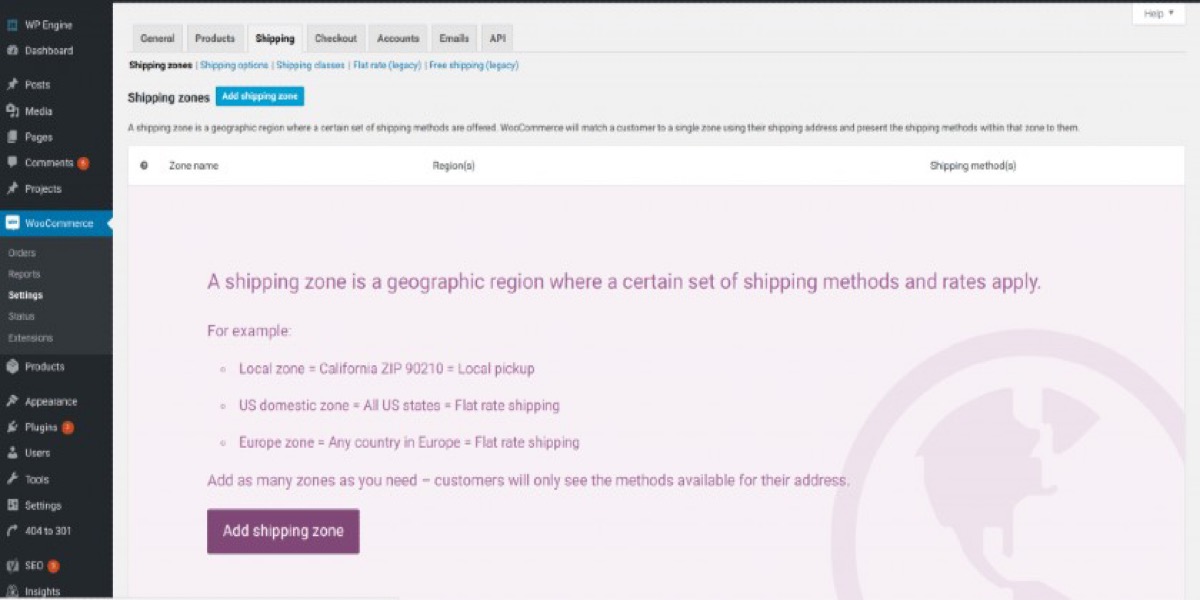
Then, to open this screen, select Add Shipping Zone:
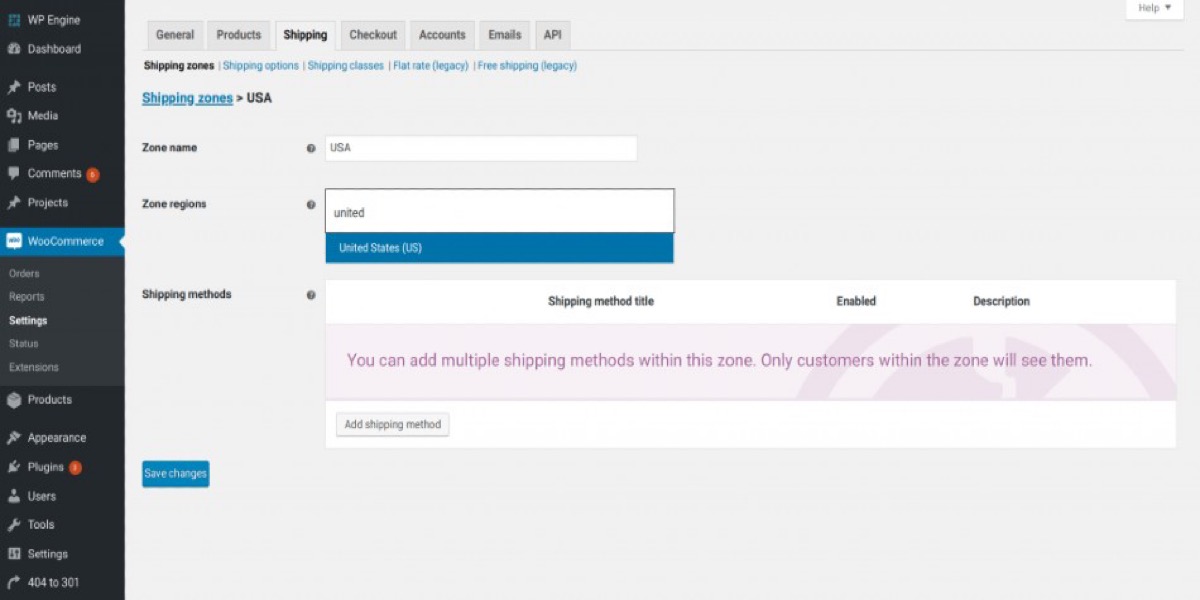
Here you’ll type in your Zone Name and choose your Zone Region. We call this zone USA because we’re setting up our US shipments, and then select United States from the region drop-down option. If you sell to additional nations, the drop-down selection will include those nations as well.
Please keep in mind that your consumers will only see shipping choices that you have set up for their zone. If you ship to both the United Kingdom and the United States, customers in the United Kingdom will not see shipping options for your United States zones, and vice versa.
Step 3: Give a Shipping method
Then, to give a shipping method to this zone, we click the Add Shipping Method option. In the next window, we can choose one of WooCommerce’s four common shipping methods:
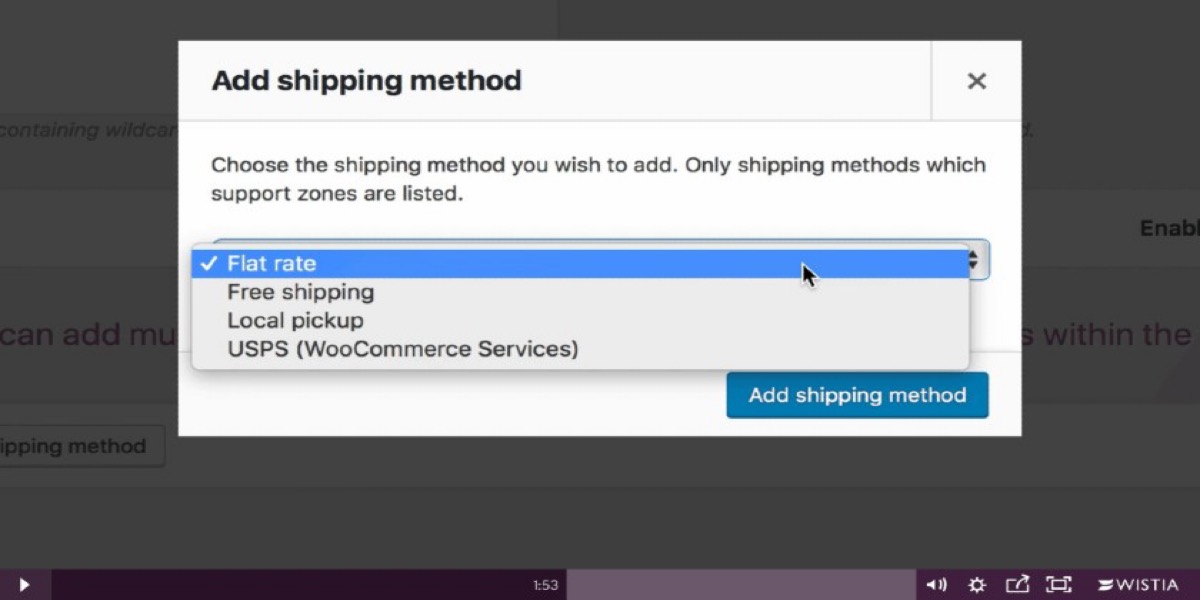
WooCommerce has a number of built-in shipping options, including:
- Free Shipping - Customers’ orders are not charged any shipping fees as a result of this.
- Flat Rate - uses flat rates to add a flat cost or a percentage of the order total.
- Local Pickup - allows customers to pick up their orders from your store, and even charge a fee if you use WooServices.
- WooServices - calculates actual USPS or Canada Post shipping prices and allows you to print USPS and Canada Post labels from your WooCommerce dashboard.
Note: For the purposes of this quick-start guide, we’ll concentrate on the built-in techniques, which are all that many vendors require. Using a third-party shipping provider like ShipperHQ, you may apply real-time rates from UPS, FedEx, and other carriers. The Table Rate Shipping Extension from WooCommerce is required for table-based shipping rates.
To save your shipping method, click Add Shipping Method after selecting it from the drop-down menu. In the Shipping Methods menu, you’ll see your new Zone/Method combination:

You can repeat this method as many times as you need for your WooCommerce store’s Zone/Method combinations. You can also modify, add, or remove methods at any moment. Your first setup decisions are never locked in.
Returning to the Shipping Zones panel, you can see the two Zone/Method combinations we set earlier:
Free Shipping for our mainland U.S. customers (called USA) Flat Rate for customers in Hawaii and Alaska (called HI and AK), because it costs us more to ship orders to these far-away states.
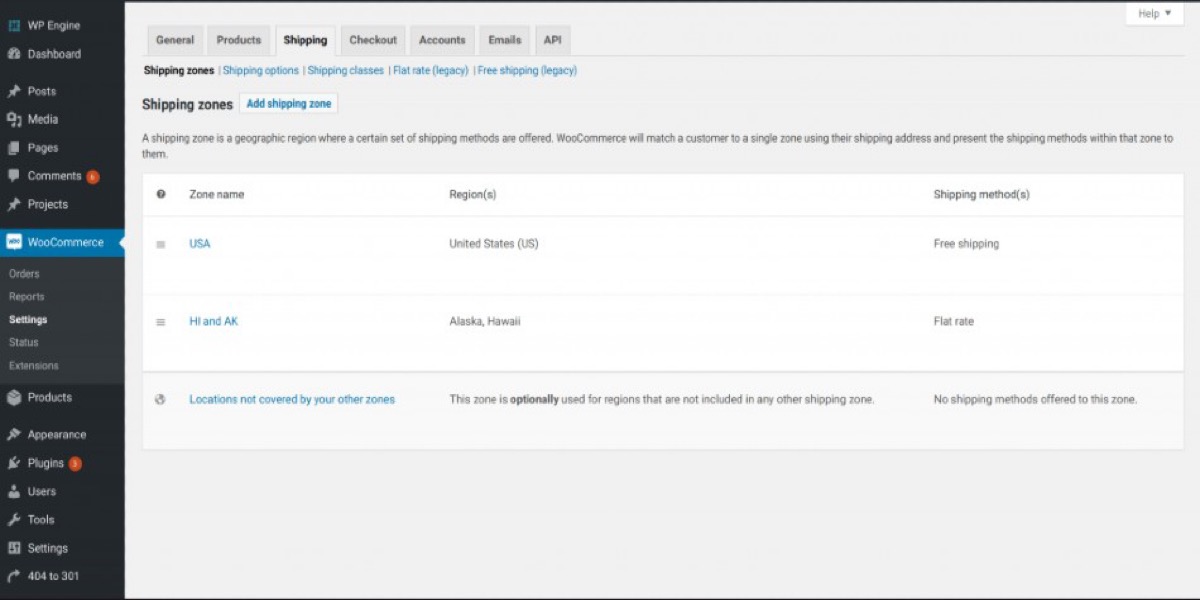
One of the advantages of WooCommerce shipping zones is this. You can create a special Zone/Method combination for Hawaii and Alaska (or any other place) and charge a special cost for those orders only.
Customers entering an Alaska or Hawaii shipping address will see the HI and AK shipping options at checkout. Our USA Free Shipping option is not available to them, and they are unable to select it. Visit the WooCommerce shipping zone tutorial to learn more about setting up and fine-tuning numerous Zone/Method combinations.
We’ll then go through how to include Shipping Rates in your Shipping Methods.
How to set up Shipping Rates in WooCommerce
Shipping Rates are the rates you charge consumers to ship their items in WooCommerce.
To summarize, WooCommerce has four built-in shipping methods for you to choose from when creating shipping rates:
- Free Shipping – Free shipping adds no shipping fees to your customers’ orders
- Flat Rate Shipping – This lets you add a flat amount or percentage of the sale total to orders
- WooCommerce Services Shipping – This lets you add real-time USPS and Canada Post calculations on orders and conveniently print labels within WooCommerce
- Local Pickup – You can enable local pickup for free or add a fee
We’ll go through how to set up WooCommerce’s Flat Rate Shipping option in this quick-start guide. It’s the most time-consuming to set up, but it’s also the most flexible of WooCommerce’s built-in shipping options. In WooCommerce shipping lessons, you can learn more about the additional built-in delivery methods.
To set up a Flat Rate Shipping cost for the Hawaii and Alaska zone we created in Step 1, go to the Shipping Zones screen and click on our HI and AK zone:

This brings up the detail screen for the HI and AK zones. In the Methods box, click Flat Rate to view the shipping rate settings for this zone:
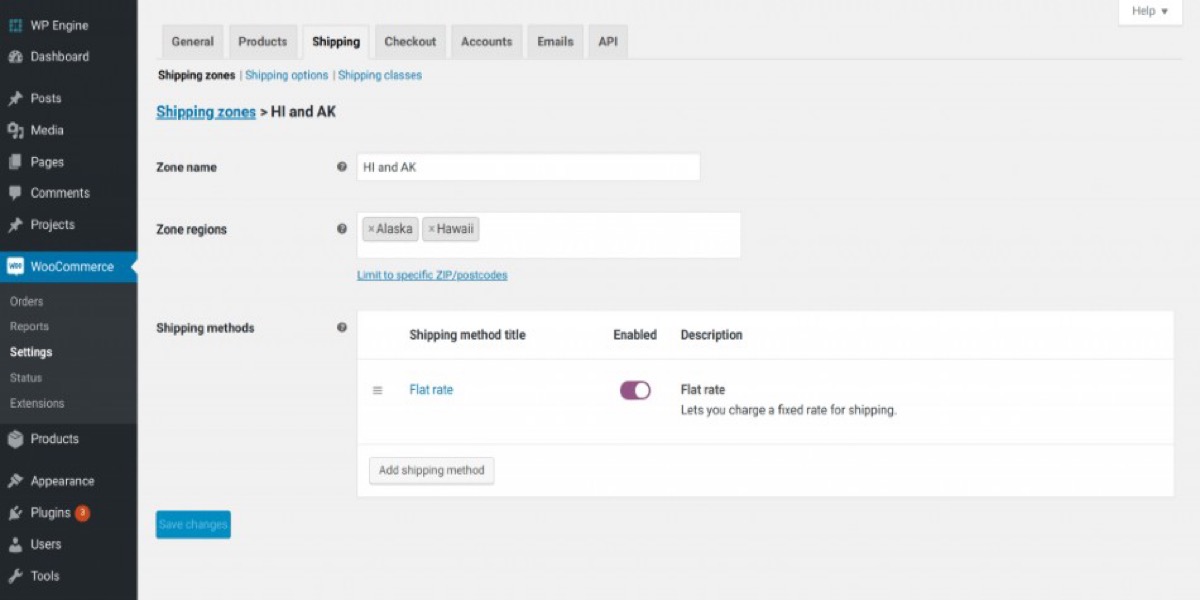
And then there’s this pop-up:
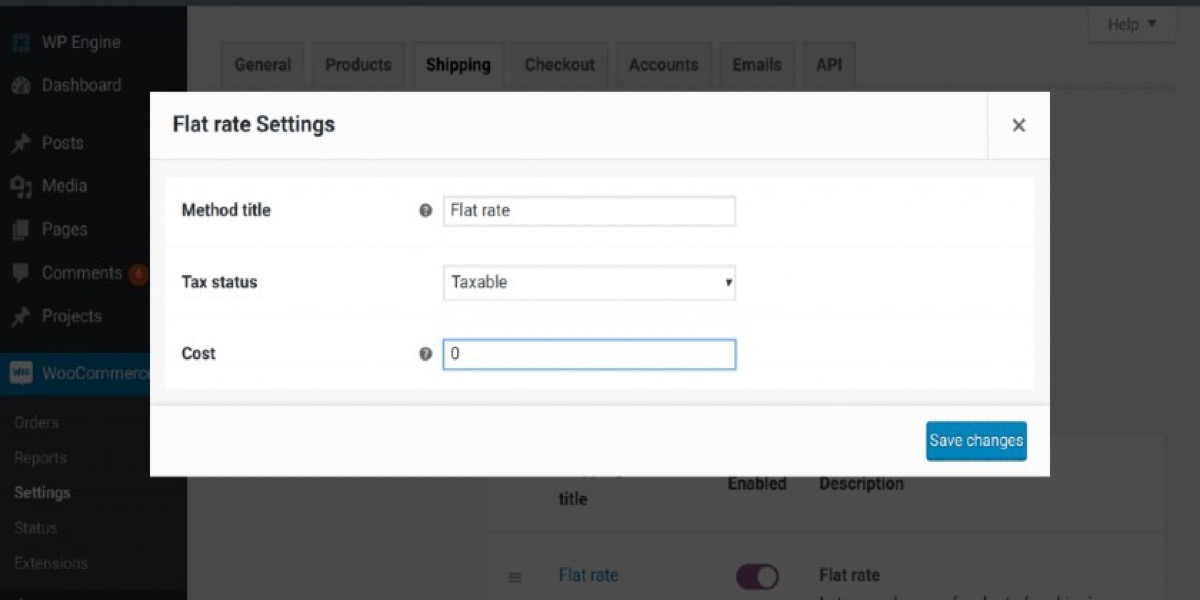
You can create flat-rate shipping prices in a variety of ways on this screen. Here are three prominent solutions that can be used for a variety of online selling requirements:
- Flat shipping fee per order
- Flat shipping fee per item
- Shipping fee as a percentage of the order total
Below, we’ll walk you through how to set up each of these flat-rate choices. In WooCommerce’s flat-rate shipping tutorial, you can learn even more options to design specific flat-rate shipping prices.
Step 1: Add a Flat Shipping Fee per Order
Simply put a sum in the Cost area, such as $2, $5, or $9.95, to apply a simple flat-rate shipping fee to every purchase shipping within a Zone:

The exact amount given in the Cost column is applied to each order when using a flat shipping price per order. All orders shipping to Hawaii or Alaska will be charged a $5 shipping fee if this setting is enabled.
Step 2: Add a Flat Shipping Fee per Item
You can optionally include a shipping charge for each item in your order. In the Cost area, enter a basic formula to get started. For instance, if you wish to charge a $2 shipping cost per order item, use the formula [qty] * 2, as shown below:
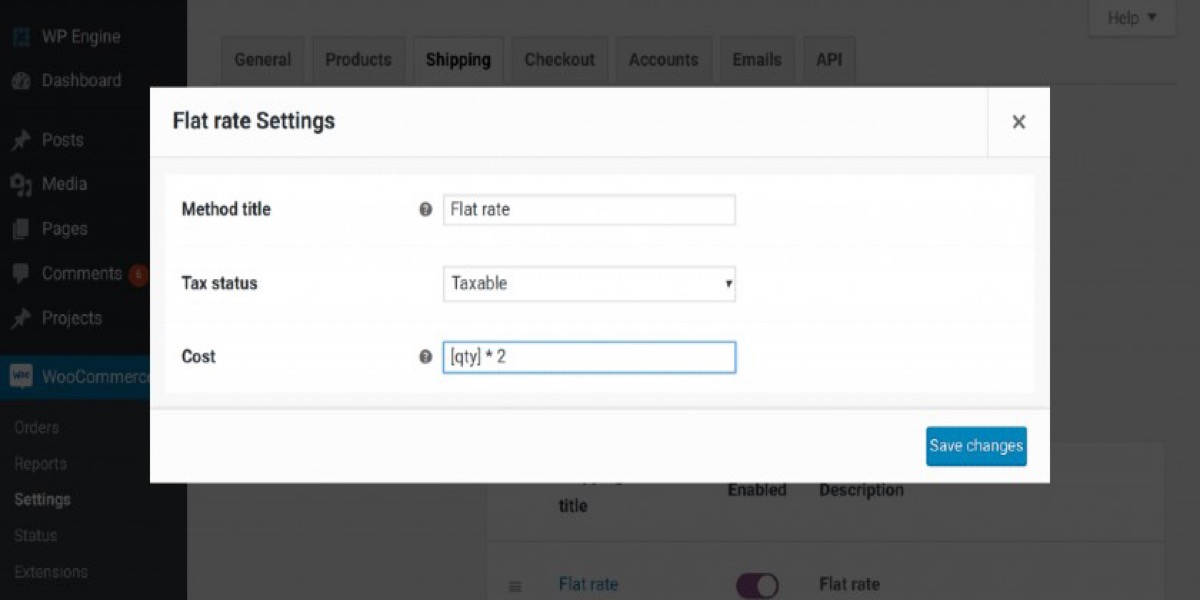
WooCommerce charges a $2 shipping price for single-item orders, but a $6 shipping fee for orders containing three items when this setting is used.
Step 3: Add a Shipping Fee as a Percentage of the Order Total
You can even charge a percentage of the total order value as a delivery cost. This is accomplished once again by inserting a simple formula in the Cost field. Enter the following in the Cost field if you want to charge a 10% delivery fee: [cost] *.10

WooCommerce charges a $1 delivery price to a $10 order, a $10 shipping fee to a $100 order, and so on, using this 10% shipping fee option.
These are just a handful of the various ways you can use basic formulas to apply flat-rate shipping expenses. More formulas for shipping fees can be found in WooCommerce flat rate shipping tutorials. In the WooCommerce Services lesson, you can learn how to apply real-time USPS prices to orders and generate shipping labels.
How to set up Shipping Classes in WooCommerce
Shipping oversized, heavy, or fragile items that require special treatment can be far more expensive than shipping standard-sized items. You can use WooCommerce Shipping Classes to apply additional shipping fees to specific items if you offer these categories of goods. Classes are an optional step, but if you don’t want to ship every item you sell for free or at a fixed rate, they’re the way to go.
Step 1: Create Shipping classes
To do so, go to the Shipping page and click on Shipping Classes:

This is the screen you’ll see:
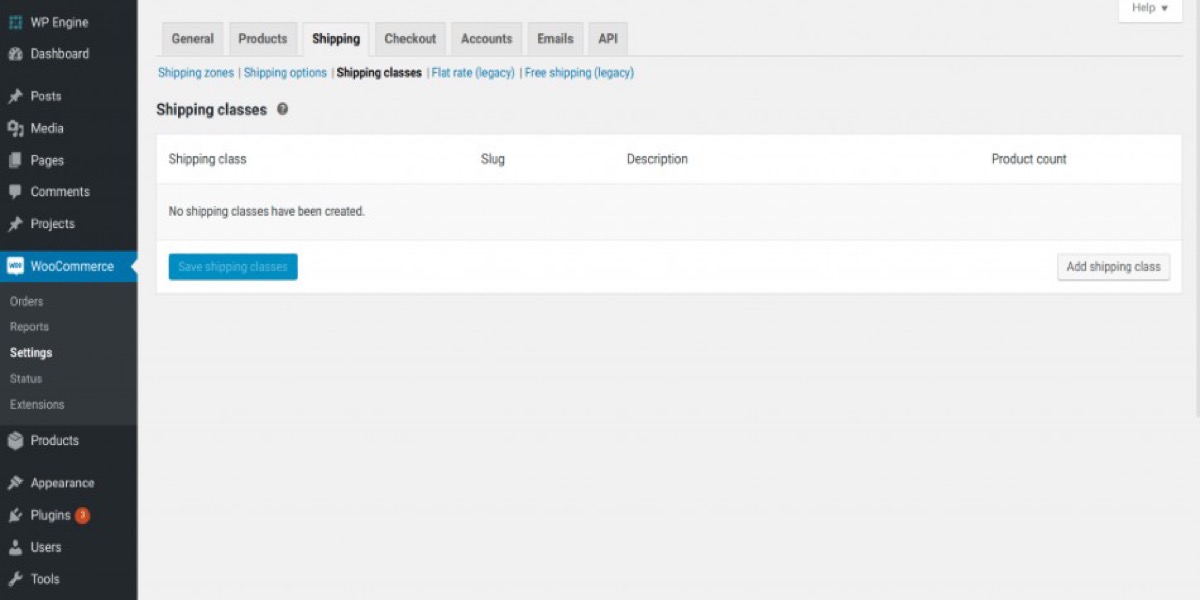
Like we did for our large Baby Gates, click Add Shipping Class and enter your class Name, Slug (typically the name again), and Description. Then select Save Shipping Classes from the drop-down menu.

Step 2: Add Shipping charges
After you’ve saved your class, go to the Zone screen in Step 1 and add shipping charges to the Class.
To do so, go to our HI and AK Zones page and select the Flat Rate method:

The Flat Rate screen has been enhanced to include a new component called Shipping Class Costs:
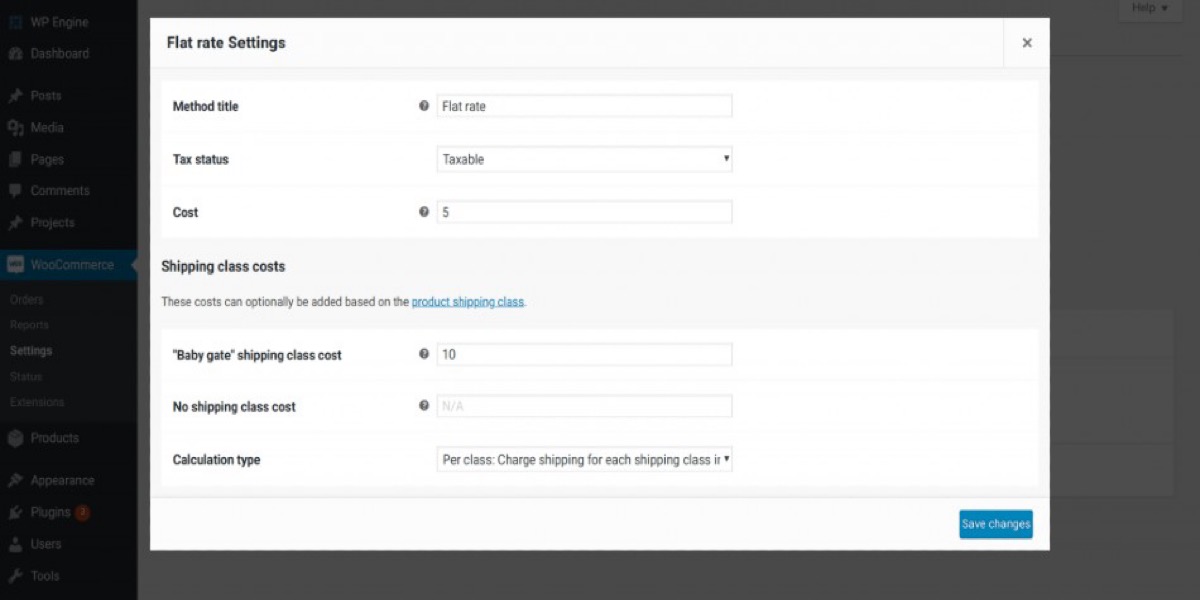
Our original $5 Flat Rate Cost is still there, but Baby Gate Class, No Shipping Class, and Calculation Type are new fields. We charged a $10 price for Baby Gate Class Cost, left the No Class section blank, and left Calculation at its default value.
Step 3: Assign gate items
Assigning all baby gate items to the Baby Gate Class is the final step in our shipping class setup. This is done under the Shipping tab of each item’s Product Edit screen:

Transporting classes are obviously essential for shipping large items, but they can also assist you better service B2B customers. You can advertise bulk order products like large case packs and even offer products in truck-freight quantities using shipping classes. Classes allow you to add appropriate shipping prices to these items, allowing B2B customers to place large orders online and know just how much shipping would cost.
4 Easy Steps To Implement a WooCommerce Shipping Strategy
Step 1: Backup Your Store
Start by making a comprehensive backup of your live shop if you don’t want to lose any of your important data. If you have a backup of your store, you can restore it to its previous optimal settings if something unexpected or unforeseen happens. Also, ensure the plugins are compatible with the most recent WooCommerce version.
Step 2: Configure WooCommerce Settings
For shipping charges to be implemented in your store, several fundamental settings must be set up. Choose the delivery type that is ideal for your company (Flat Rate, Free Shipping, Table Rate, and Local Pickup). Remember to add shipping zones where you deliver and, if necessary, create shipping classes.
Step 3: Install Plugins For Additional Shipping Features
The nice aspect of WooCommerce is that you can customize your default settings to make them more interesting. The same is true for shipping; with a few plugins, you can drastically improve the efficiency of your delivery plan.
Step 4: Test Your Shipping Strategy
No one wants to shop from a defective website, and I certainly won’t. As a result, thoroughly testing every part of your website is essential. As a result, your delivery plan should be the same. After you’ve established all of your shipping options, properly test them before releasing them to your clients. This is what your testing checklist should look like:
- Test a product from each shipping class and zone you’ve set up.
- Try different combinations of cart sizes and products to ensure that shipping methods are applied correctly.
- Perform a thorough checkout to ensure that all third-party plugins are functioning properly.
- Double-check that tracking numbers are included in customer communications and that they are also visible on account pages.
- Rewrite your shipping policies so that they are simple to comprehend for your clients.
- Double-check that the price your customers see matches the price your carrier charges if you’re using live rates.
Conclusion
If you sell tangible things, one of the most crucial components of your success is delivery. Customers who purchase online want to spend the least amount possible for products that arrive swiftly and in pristine condition.
Begin by learning the fundamentals of shipping techniques and fulfillment before deciding on the best shipping plan for you.
I hope you find this topic about How to Set Up Your WooCommerce Shipping useful!





